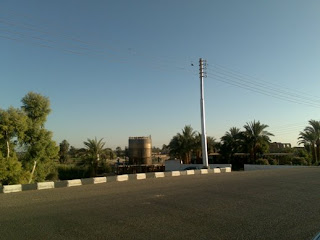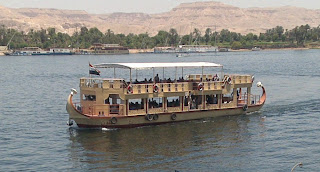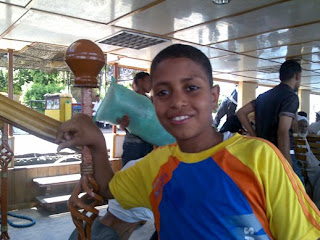I just recently had to write an essay about the conventions of 2 dimensial Egyptian art and gave it to one of my guests to review before I submitted it. She found it really helpful to read before she visited the tombs so I thought I would give a section of it a wider audience. Especially now it has been marked and I have not made any glaring errors. The biblography is at the end and I really recommend Gay Robbins book's, she is by far the most readable.
It is important when looking at Egyptian wall paintings to remember what we are looking at. This is not some pretty picture to cheer up a tomb but it had a vital and significant purpose . To provide for the deceased in the after life. The artist could not experiment or he might destroy the whole purpose of what he was trying to achieve. Art as, defined by European standards , did not exist, the decoration of the tomb had a specific function and, as such, artistic considerations were not important. According to Aldred (1980 p15) the artist “… represented not what could be seen transiently, but what he expected to exist for perpetuity, symbols rather than images”.
This does not mean the tombs are devoid of beauty but rather should be viewed with an unprejudiced eye. The tomb craftsman used two dimensional art to fully represent what he was trying to show. It was ‘fit for purpose’; indeed it was more than that as some of the small vignettes are testimony to skill to the largely unknown craftsman. Indeed “to represent was, in a way, to create” (Robins 1997 p12) so they needed to represent the clearest picture of the object or figure, so it was instantly recognisable.
The Figure
The figures in the tomb were drawn according to a convention that was well established, first shown on the Narmer palette. The convention was: head in profile, eye full frontal, shoulders full frontal with distinct collar bones, arms in profile, hand does not appear as a hand but as a symbol for a hand, upper chest side view with one nipple, navel three quarters with belly button showing two thirds along, legs profile, feet striding, inner side of foot always shown so depending on the direction of the figure there will be two left or two right feet (Smith 1946 p273 Robins 1990 p14). It is not until the New Kingdom that both left and right feet will be shown. Mostly the figure is shown facing left which means when it was turned to face right, for example on both sides of a doorway, it can be a little clumsy.
The Cannon of Proportion
Not only was the figure drawn according to this convention but the figure also has rules about proportion. Some Egyptologists believed that these rules are rigid. “The small cubit equals the length of the arm from the elbow to the tip of the outstretched thumb. It is divided in 6 hand breadths, each of 4 fingers, measured across the knuckles at the back of the hand. Each finger has sub division ½ 1/3 ¼ 1/8 1/16. An extension of the hands breadth is 5 fingers or 1 ¼ hands breadth. The fist represents 4 fingers and thumb (which equals 1 1/3 fingers), making 5 1/3 fingers or 1 1/3 handbreadths, 2/3 of the cubit is the length of the arm elbow to wrist, which is equivalent to 4 handbreadths. It corresponds to a foot in Greek metrology. Lastly we have the fathom, which measures 4 small cubits and represents the height of a standard standing male figure.” (Iverson 1975 p22)
“As has been the custom, we take the baseline as 0 and count upwards horizontal 5 runs beneath the knee cap, 6 above the kneecap, 7 beneath the tips of the fingers hanging by the body, 8 under the thumb, 9 beneath the buttocks, 11 through the naval, 12 through the elbow, 14 through the nipple, 16 through the junction of the neck and shoulders, 17 beneath the nose, 18 through the hairline” (Robins 1994, p36). A proper grid is a later tool and during the Old Kingdom it is not often seen.
“Based on the small cubit the figure is drawn. Although grids are not generally used at this time, Old Kingdom figures can be analysed on the bases of hypothetical grids.” (Robins 1990 p35).
However whilst grids, rules and lines are common they were not always followed exactly and good artists did not always need them. “Once Iverson has established his hypothetical system, he attributes discrepancies between it and the material to errors arising from the incompetence of the artist.” (Robins 1994 p53). So it is a mistake to think that grids and rigid rules were always used, perhaps one could theorise that the very worst and the very best did not . “One has to assume, therefore, that these lines were merely aids to the artist and he was not tied to them”. (Robins 1994 p66) and “…proportions are not dependent on the grid and that the grid was simply adopted as an aid to obtaining them” (Robins 1994 p229)
Groups of Figures
Size matters, the most important person in the scene is the biggest, if shown “the king and the deity are equal footing” (Robins 1994 p8). However the most important person in an Old Kingdom noble’s tomb is the owner, as neither the king nor a god appears until after the Old Kingdom. He is the dominant figure in every scene. Men are in front of women , who are usually shown on a smaller scale or occasionally on the same scale. Adults are always shown in their prime, women are slim, and men are muscular. “The owner could be displayed either as a young man with a short kilt or a mature man with a calf length kilt. The wife was always displayed young as maturity might indicate lack of fertility.” (Robins 1997 p76). “The elite have no disease, deformity or old age…identity was established by the inscriptions” (Robins 1997 p75).
Young are shown as mini adults with a finger to their mouth or forelock of youth and they are generally nude.
Depiction of the minor figures in a scene was much more flexible and here you see much more lifelike poses and attitudes, humour or a snap shoot of real daily life.
“Where as major figures had to be depicted as ideal in formal poses, minor figures could be shown as far from perfect, perhaps suffering from deformity, disease or hunger, in positions which caught the body in transitory actions or engaged in energetic movement.” (Robins 1990 p38)
The Tomb
Neither time nor space are reflected and within the same set of registers you could see ploughing and threshing, gathering grapes and bottling wine. The figures and objects completely fill the space available with appropriate hieroglyphic inscriptions filling and balancing the scene. The only occasion registers are not used is when there is a deliberate invocation of chaos, a desert hunting scene, a battle or a marsh hunting scene.
The central figure was usually male, accompanied by wives , parents and offspring. His titles and name would be constantly repeated and a biography would be included . There would be a false door connecting the dead with the living. The deceased would be shown before a table of offerings and there could be a procession of offering bearers. There would be the production of further supplies in scenes of everyday life showing the production of food, clothing, objects (furniture, jewellery, and boats). “The owners would be shown benevolently supervising these activities.” (Aldred 1980 p87) The peasants are shown in a variety of lively poses. The owner is shown taking an active part in fishing and fowling in the marshes and hunting in the desert. These have the threefold purpose in the afterlife, enjoyment, food provisions and also the religious concept of overcoming chaos. The depiction of the funeral would ensure the correct funerary rights. The common scene of the clap net being employed in the marshes shows the owner bring order and rule to the chaos of the marches, as he hoped would happen in both life and death.
A mixture of carving styles was used depending on where the scene appeared.
Traditional, sunk relief was used on the outside walls and raised relief on the interior ones. (Robbins 1997 p25). It would often be indicative of a reward from the king that a noble had a top quality tomb. The best non royal tombs would belong to members of the king’s family or very senior members of his court. “The ability to command first rate artists displayed the tomb owner’s wealth and status”. (Robbins 1997 p25)
Perspective v Plan
They draw things in plan because this shows most of the contents. If you drew a building with an enclosure wall drawn in perspective you would know nothing of the interior of the wall. By drawing in plan you can seen the house and garden. The art is “conceptual rather than purely perceptual” (Robins 1990 p11). If you take the plan of a house you have no idea of the internal structure when shown in perspective, it was important to the Egyptians that this would understood and represented. Indeed the hieroglyphic for house and courtyard show the plan rather than the elevation or perspective.
There is an attitude that not showing perspective is somehow primitive or naïve and that being aware of it they should use it. “…men have always been conscious of the phenomena of perspective at all periods, but for some reason they have not at all periods made use of this awareness in their drawing”. (Schafer 1986 p81).
Fig 1
http://www.excavacionegipto.com/campana/campana04_ing.jsp.htmHowever the apprentice board discovered by Dr Jose Galan in the courtyard of TT11 shows us in unmistakeable terms that the Egyptian artist was capable of fully representational drawings. This board, Figure 1, shows a picture of the king fully frontal. It is thought to have been a practice piece for a sculpture. There are two drawings side by side, one by the confident hand of a master and the other by the more hesitant hand of a student. As the shoulders are five squares across it is believed to be a representation of Hatshepsut as females are traditionally shown with the smaller shoulder width where as a male would be six squares across. The second picture shows the reverse of this piece with the more usual sideways view. It shows us that artists were taught both methods but only one type would appear on a wall and the other would be used for sculpture. But they could do it and were obviously expected to.
Offerings & Contents
These are vital to the survival of the owner so need to be shown in detail from the best possible angle to make it completely obvious what they are. A table would be shown with the contents tipped or piled up so every object is clearly defined.
The contents of a chest or box are drawn individually above the container. Again without this the contents would not be useable by the owner. The figures would be shown carrying offerings so in the unlikely event of the descendents neglecting to provide offerings; a combination of artistic skill depicting offerings, the hieroglyphics removing any ambiguity and magic e.g. the opening of the mouth, would provide for the tomb owner.
“The drawings could occasionally reinforce the hieroglyphs with a picture of a scribe having the palette and staff that comprise the hieroglyphics for scribe. Likewise offering bearers are shown carrying the hieroglyphic for offering” (Robbins1997 p51).
Magic
“… the role of representational art was closely interwoven with the religious beliefs of the ancient Egyptians and often one cannot be understood without reference to the other.” (Wilkinson 1992 p11). He continues “It is only knowledge of this aspect of Egyptian Art which can transform such a scene a relatively meaningless to the richly detailed tapestry of symbols which the artist originally produced”

Figure 2 tomb of Kheruef (photo Ray Johnson 2008)
The ceremony of the opening of the mouth will make these drawings come alive so they will sustain the owner but they could also bring danger to him so certain hieroglyphs will be incomplete or cut through so the dangerous creature would not hurt the owner, see Figure 2. This mutilation of hieroglyphics is shown in Pyramid Text and it demonstrates how vividly the Ancient Egyptian believed in the magical potency of the pictures. Likewise removal of the name beside a figure is enough to remove that person from the tomb .
Scenes often reflect mystic values such as order v chaos, the battle against demons in the after world . The clap net bringing order to the marshes. Spearing the hippopotamus destroys the demons of chaos.
Colour
Tones and shading are not shown but there is some clever use of colour including a white, white and a black black. The white white is shown on a kilt (hunite) on the while back ground (Calcium Carbonate). (Robbins 1997 p27). Also black, black wigs or the ‘T’ glyph on a black background. Although men are shown a reddish colour and women a yellow sometimes there are variations of this where several people are shown on top of each other and there is a need to differentiate or a very high status man will be shown a lighter shade than the workers in the field. (Francisco Tiradritti pers comm. 2008).
Biblography
Where is says personal communication these are from lectures at the Mummification Museum.
Aldred, C. (1980), Egyptian Art in the Days of the Pharaohs, 3100-320 BC, Thames and Hudson, London.
Harper Y & Scemin, P (2006) the Chapel of Kegemni, Oxford University Press
Iversen, E. (1975, 2nd edition), Canon and Proportions in Egyptian Art, Aris & Phillips Ltd, Warminster.
Robins, G. (1997), The Art of Ancient Egypt, British Museum Press, London.
Robins, G. (1990), Egyptian Painting and Relief, Shire Books, Princes Risborough.
Robins, G. (1994), Proportion and Style in Ancient Egyptian Art, University of Texas Press, London.
Schafer, H. (1986), Principles of Egyptian art, translated and edited with an introduction by J. Baines; foreword by E.H. Gombrich, Griffith Institute, Oxford.
Smith, W (1946) A history of Egyptian Sculpture and Painting in the Old Kingdom, Oxford University Press
Wilkinson, R (1992) Reading Egyptian Art, Thames & Hudson
http://www.excavacionegipto.com/campana/campana04_ing.jsp.htm (Accessed February 2008)









